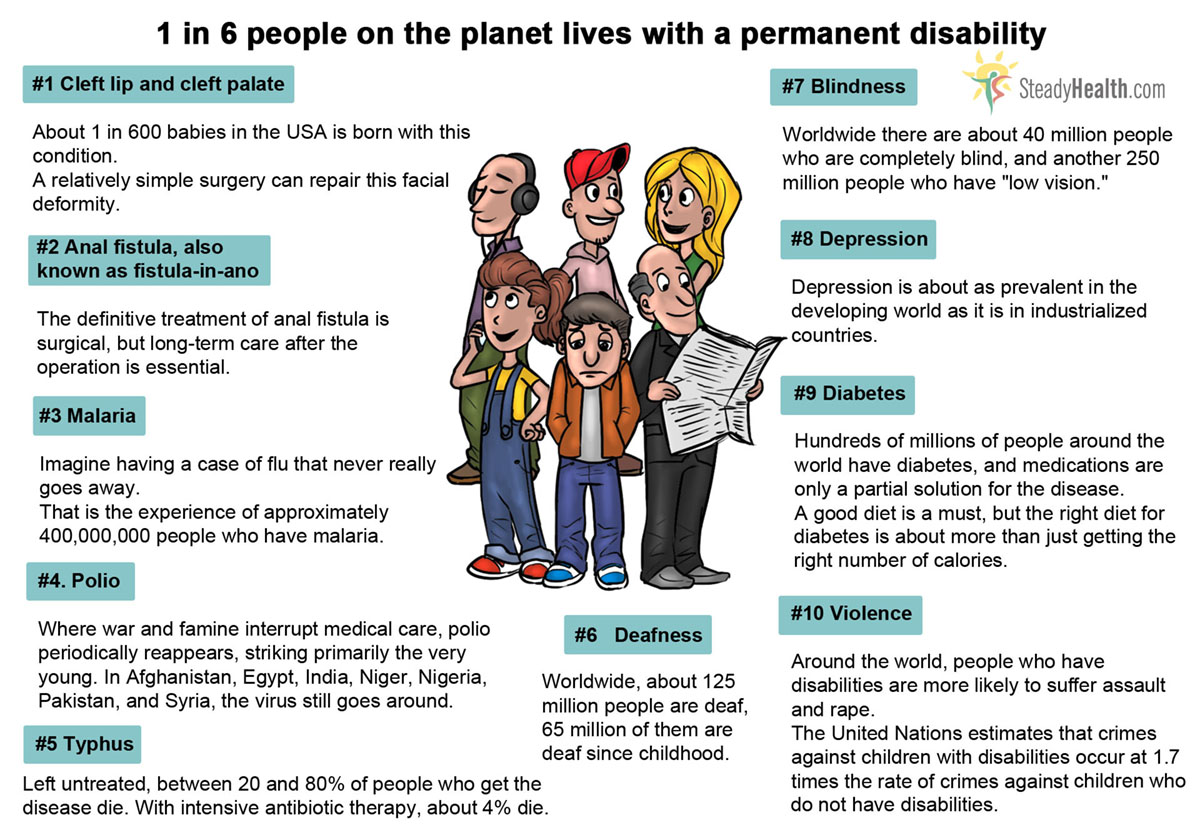Health officials affiliated with the United Nations tell us that over a billion people worldwide live with a serious disability, but the most serious disabilities are often conditions that people in the developed world never hear about.
1. Cleft lip and cleft palate
A cleft is a separation of the lip or palate from the roof of the mouth. The cleft can affect either the lip or the palate, or both. Baby boys with the condition are most often born with both cleft lip and cleft palate, but baby girls with the condition are most commonly born with a normal lip and only a cleft palate.
A relatively simple surgery can repair this facial deformity, but in much of the world it is simply not available. Additional procedures may be required as the child grows to improve speech, dental alignment, and overall facial appearance. Speech therapy is often recommended to address any speech difficulties. Organizations like Smile Train recruit doctors to perform corrective surgeries for free around the world.
2. Anal fistula, also known as fistula-in-ano
An anal fistula is a essentially a second anus formed by the erosion of tissue between the rectum and the skin. It makes personal hygiene difficult, and as a result, people who have anal fistula often have to lead their lives in isolation, excluded from work and social opportunities.
Millions of women are believed to suffer this condition in sub-Saharan Africa, although exact counts have not been made.
The definitive treatment of anal fistula is surgical, but long-term care after the operation is essential. Common surgical options include fistulotomy (cutting open the entire fistula tract), fistulectomy (removal of the fistula tract), seton placement (placing a thread-like material to help drain the fistula and keep it open), and more advanced techniques such as fistula plug or advancement flap procedures.
Because of the location of the lesion, antibiotics are essential, and most patients also need some kind of ongoing anti-inflammatory medication. In the United States, the drugs most commonly prescribed after the surgery cost tens of thousands of dollars per year. In the developing world, treatment is extremely difficult.
3. Malaria
That is the experience of approximately 400,000,000 people who have malaria. One of the major challenges in treating malaria is that it usually takes a combination of drugs to get rid of the malaria parasite, and serious complications have to be treated with drugs administered by IV. Still, progress is being made in treating this incredibly common parasitic infection.
Preventive measures are essential for reducing the risk of malaria. These include taking antimalarial medications before, during, and after travel to endemic areas, using insect repellents, wearing protective clothing, sleeping under bed nets treated with insecticide, and avoiding mosquito bites, particularly during peak mosquito activity times.
A malaria vaccine called RTS,S/AS01, also known as Mosquirix, has been developed and is being piloted in some countries. It provides partial protection against malaria in young children but is not yet widely available.
Read More: Polio (PPS): Symptoms & Treatment
4. Polio
Fifty years ago, just about everyone knew someone who had had polio. While most people survived the disease, they might be left with limbs that just didn't work, because of the destruction of nerve tissue. And the symptoms of the disease might only show up 10, 20, 30, or even 40 years after the initial infection.
Polio is prevented by innoculation, but it has never completely disappeared.
In the seven countries where the virus still goes around, Afghanistan, Egypt, India, Niger, Nigeria, Pakistan, and Syria, every year hundreds to thousands of children are struck by the disease. Only a majority die or suffer permanent disability, but even these few deaths and disabilities are preventable.
Vaccination is the most effective way to prevent polio. The oral polio vaccine (OPV) and the inactivated polio vaccine (IPV) are used for immunization. Routine vaccination with multiple doses is recommended to provide long-lasting immunity.
Six More Disabilities Affecting Millions
5. Typhus
Typhus is a disease transmitted by fleas on rats, cats, opossums, and flying squirrels. Over a million people died of typhus in a single year at the end of World War II, but in the twenty-first century the disease is limited to South Asia (especially Nepal and India), Southeast Asia (especially Malaysia in the dry season), Central and South America, northern China, Africa, and northern Australia.

The key to controlling typhus is controlling rats and the animals that feed on them. That is a challenging task where rats can feed on fields of grain and people live in conditions that nurture fleas. The solution to the problem of typhus is careful hygiene, but living a life free from fleas is hard if you live in poverty.
6. Deafness
While many deaf people regard their deafness as "different" rather than disabling, there is no doubt that deaf people face many barriers to their full participation in society.
Deafness is most common in Egypt, Saudi Arabia, Iran, Pakistan, India, Thailand, and Indonesia, where the condition is about 3 times more frequent than the world average. Deaf people around the world deal with difficult choices in dealing with deaf culture and the hearing world.
There are different communication options available for individuals with deafness, depending on personal preferences and circumstances. These can include sign language (such as American Sign Language), lip-reading, speech therapy, assistive listening devices, cochlear implants, and hearing aids.
7. Blindness
Surprisingly, the most common cause of blindness is a form of retinitis that can be corrected with a single dose of vitamin A - costing about 3 cents to manufacture but as much as $50 to deliver to a remote village - and the most common cause of low vision is simply not having glasses to correct nearsightedness or astigmatism.
Some causes of blindness may be preventable or treatable with timely medical intervention. Regular eye exams, early detection, and appropriate management of eye diseases or conditions can help preserve vision or slow down further deterioration.
8. Depression
Depression is a state of low mood and inactivity, resulting in withdrawal from social life and loss of productivity on the job. In many cultures, there simply is no concept of depression corresponding to its definition in the West. However, the World Health Organization (WHO) estimates that depression is about as prevalent in the developing world as it is in industrialized countries.
The exact cause of depression is not fully understood but likely involves a combination of genetic, biological, environmental, and psychological factors. Trauma, major life changes, chronic medical conditions, substance abuse, and family history of depression can increase the risk.
Treating depression is difficult under the best of circumstances. However, depression is less of a "hidden burden," to use the WHO's terminology, than it once was, and treatment for depression is becoming available in more and more places around the world.
9. Diabetes
Diabetes was once very rare. Then there was an epidemic of type 2 diabetes in the United States. By 2013, however, there were more diabetics in Mexico, Saudi Arabia, and the People's Republic of China, as a percentage of population, than in the USA.
Poorly managed diabetes can lead to long-term complications, including heart disease, stroke, kidney disease, nerve damage, eye problems (retinopathy), foot problems, and skin conditions. Good blood sugar control, regular check-ups, and early intervention can help reduce the risk of complications.
Good diet is a must, but the right diet for diabetes is about more than just getting the right number of calories.
Read More: Diabetes Symptoms: A Silent Killer Disease
10. Violence
Around the world, people who have disabilities are more likely to suffer assault and rape.
And in many countries, violence is the main cause of disability, especially in countries that have experienced civil war.
There are ways of dealing with every disability--if the right resources can be matched with the people who need them. On this International Disabilities Day, reach and help if you can.
- Cox-Singh J, Davis TM, Lee KS, Shamsul SS, Matusop A, Ratnam S, et al. Plasmodium knowlesi malaria in humans is widely distributed and potentially life threatening. Clin Infect Dis. Jan 15 2008. 46(2):165-71.
- Dionisopoulos T, Williams HB. Congenital anomalies of the Ear, Nose and Throat. New York: Oxford University Press, 1997:243-62.
- Mindmap by steadyhealth.com
- Photo courtesy of Ed Yourdon by Flickr : www.flickr.com/photos/yourdon/2987128975/



Your thoughts on this